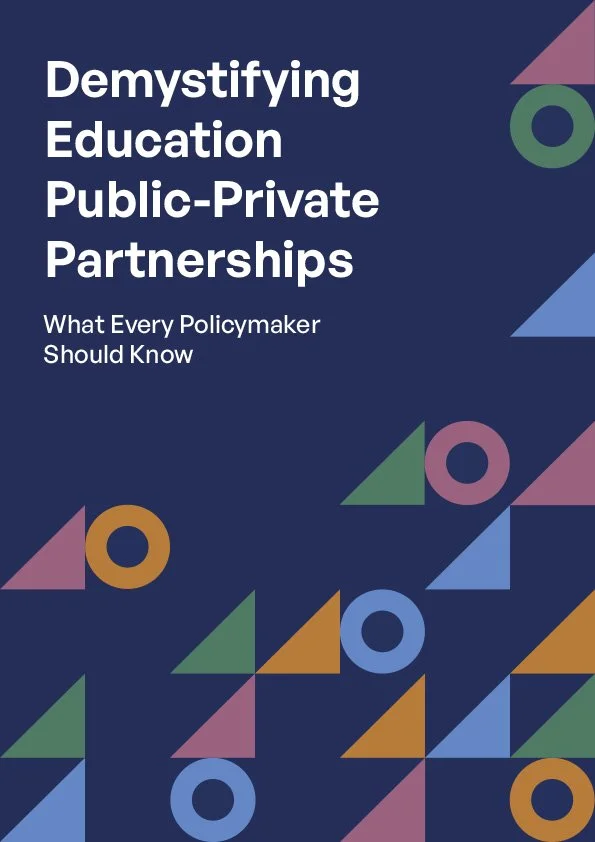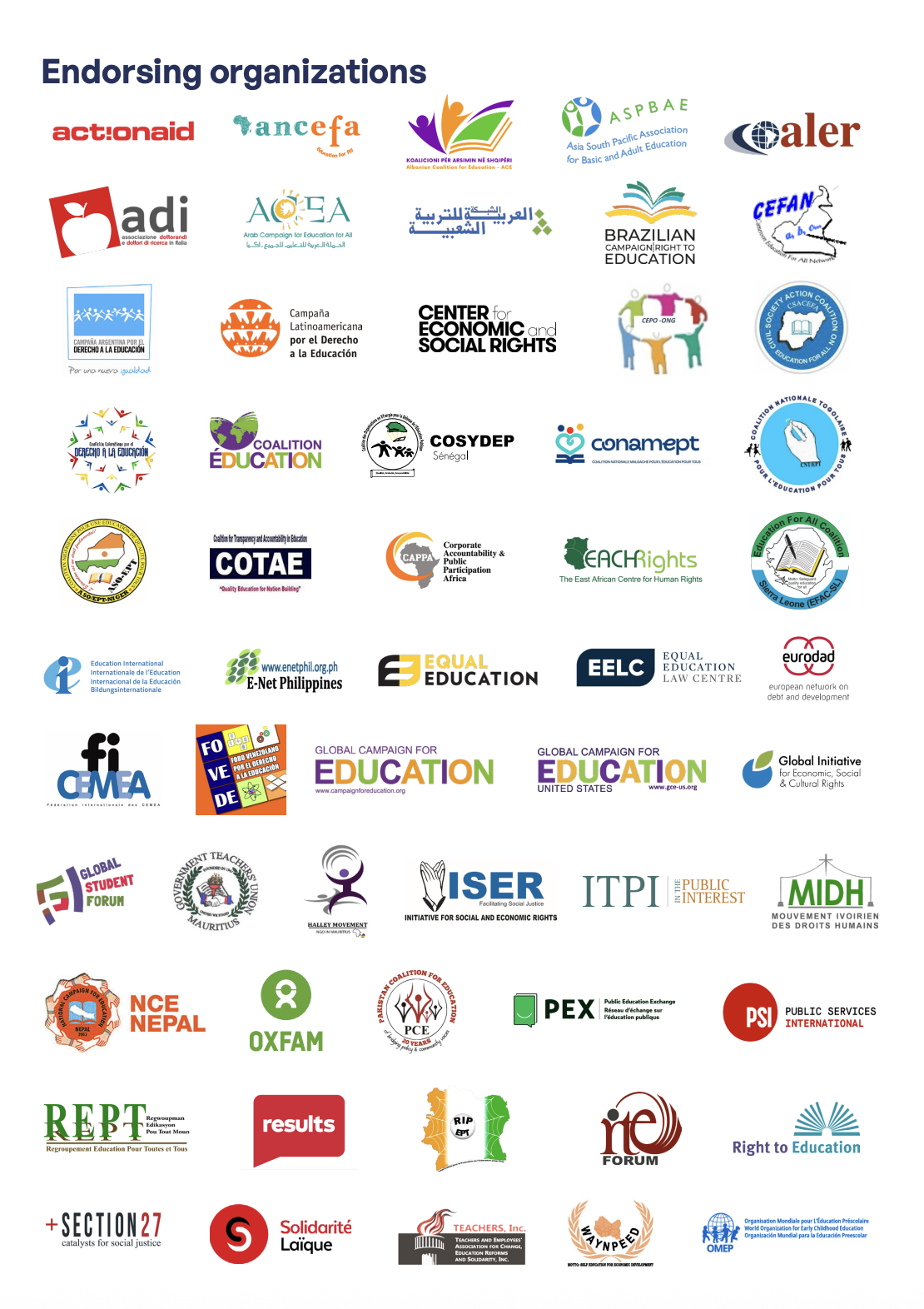Public-Private Partnerships in Education
Sorting facts from myths
Our policy brief, Demystifying Education Public-Private Partnerships: What Every Policy Maker Should Know, endorsed by 57 organisations across the globe, provides guidance to support more informed and strategic decision-making regarding education PPPs, protect public resources, improve policy implementation and enhance accountability.
Download the full Policy Brief
Download the full Working Paper
A growing number of international actors are encouraging governments to turn to the private sector to relieve the burden from or help fix failing public school systems. Powerful development actors like the World Bank, the International Monetary Fund, and other donors have supported this privatisation push.
This brief examines the performance of one prominent manifestation of this trend – the growth of Public-Private Partnerships (PPPs) in education. PPPs are long-term contractual arrangements where the private sector provides infrastructure, assets, and/or services traditionally funded and managed directly by governments. They often include some form of risk sharing between the public and private sectors.
Governments considering entering a PPP
Public-Private Partnerships advocates argue that they are: more efficient and save government resources, innovative and can address the learning crisis and rapidly scalable. Also, policymakers are told that PPPs can reach geographies and students that the state cannot and reflect citizen choice and offer ample space for accountability.
The reality of PPPs
-
PPPs are not a panacea for limited budgets because they:
have misaligned interests and incentives. The primary goal or motive of private sector partners is typically profit, whereas the public sector’s goal is to provide high-quality public education to all students. The desire to keep costs down risks triggering pedagogically dubious cost-cutting measures which can negatively impact educational outcomes. PPPs actually increase the government’s role since it needs to enhance its capacity for procurements, monitoring and evaluation, governance and regulation. Indeed, the World Bank’s 2018 World Development Report concludes that governments may deem it more “straightforward” (i.e. efficient) to provide quality education than “to regulate a disparate collection of providers that may not have the same objectives.”
often cost more while undermining fiscal sustainability, particularly when governments ignore or are unaware of their deferred costs and associated fiscal risks. PPPs across sectors tend to be more expensive compared to public procurement. Estimates show that the total transaction costs of all types of PPPs could be as high as 20% of the project value.
are difficult and time-consuming to negotiate when protecting educational interests, and often force governments to absorb risk when projects fail. PPP contracts are much more complex than direct delivery by the government because they need to address all possible contingencies likely to be encountered over the contract duration. Poorly managed PPPs can lead to inefficiencies, cost overruns, and project failures, thus exacerbating budgetary pressures. When partnerships fail, states must intervene to fulfil unmet goals and responsibilities, a cost not included in most cost-benefit analyses of PPPs. PPPs can also create unsustainable dependency on external funding and expertise.
do not lower the state’s burden since the politics of the PPP may become challenging. PPPs are viewed publicly as entities owned by the private party, which can result in reduced political support.
can reduce funding available for government schools in order to meet contractual obligations resulting from a PPP. For example, in the U.S., while Arizona increased its spending on voucher programmes by 270% between 2008 and 2019, the state decreased its per-pupil funding for public education over this period by 5.7%.
bring weaknesses associated with the private sector into the public system, including removing social obligations to students, increasing business management culture at the expense of transformative education, and declining public accountability.
still involve direct or indirect payment by taxpayers and/or students. The government pays for the costs of the PPP from taxation for a service that the public system could provide. If the PPP allows fees levied from students, the service is still not free; the costs are passed directly to students’ families instead of being paid through public budgets.
-
PPPs harm equity. They often recruit the “cheapest to educate” students while discriminating against those with additional educational needs. Most research on education PPPs shows negative equity impacts and increased school segregation, particularly in partnerships with for-profit entities. Chile’s voucher programme, the world’s largest, has resulted in high education inequality and segregation with the poorest students generally concentrated in neglected, low-performing government schools. PPPs have a particularly adverse impact on students from marginalised backgrounds. A study of 17 countries found that “in a majority of countries, [PPP schools] are reinforcing social disparities by disproportionately serving students in the upper-income quintiles.” Similarly, women and girls have a greater risk of marginalisation.
PPPs leave government schools to educate those with the highest educational needs, putting public schools under even greater pressure given the redirection of resources to PPPs.
PPPs often fail to bring new students into education, instead displacing students from other schools. Research from Punjab, Pakistan shows that increased enrollment in a PPP appeared to stem from pulling in students from other private schools. In another instance, establishing a new PPP school reduced neighborhood public school enrollment by 3%.
-
Private schools do not inevitably perform better than government schools and any difference does not translate to PPPs. Any difference in the quality of education between PPPs and public schools is marginal, often disappears after factoring in the socio-economic background of the pupils, and stems from the adoption of organisational strategies, such as longer school days, and instructional practices more oriented toward discipline, ability grouping, and external test preparation (please see the endnotes in the Policy Brief). An analysis of the Organisation for Economic Co-operation and Development’s Program for International Student Assessment (PISA) across 17 high- and middle-income countries found no achievement advantage in PPP schools after accounting for student selection and peer group effect, finding that “PPP schools appear to be outperforming public schools not through any superior or innovative practices, but rather by cream-skimming more capable students into the private sector.”
PPPs cut costs by diminishing the teacher profession. Any “efficiency gains of PPPs usually come at the cost of worsening working conditions for teachers,” with long-term implications for the quality of teaching and learning. Doing so ignores the critical role teachers play in improving quality. PPPs often do not place sufficient emphasis on teacher training and professional development, opting instead for increased investments in technology.
Private providers in PPPs tend to favour traditional education approaches over experimentation. Their innovation often focuses on symbolic aspects, such as school marketing, and management practices, but not necessarily pedagogy and classroom practices (please see the endnotes in the Policy Brief). PPPs’ market logic forces them to maintain a short-term focus, prioritising rapid financial returns over longer-term educational outcomes.
-
PPPs rarely scale. While pilot projects or small-scale interventions might succeed, scaling these initiatives towards meaningful national impact presents serious logistical and planning challenges that governments already face in the public system. Building new facilities, recruiting qualified staff, and developing robust administrative systems require larger initial investments and take time, causing PPP implementation on a limited scale that fails to reach the broader population affected by the learning and access crisis.
PPPs also lack meaningful consultation and ownership from communities (parents, learners, teachers, etc.). When PPPs design and implement programmes without consulting and involving local stakeholders, they may either fail to address the specific needs and challenges or foster resistance to change and a lack of trust. Failing to build support for a given “reform” risks the PPP devolving into churn that stakeholders eventually tune out, preventing opportunities for real educational gains.
PPPs find maintaining quality while scaling difficult. Scaling up quickly can compromise quality if adequate control measures are not taken and is constrained by the availability of skilled teachers and administrative staff who are hard to find, train and retain. Thus, in Punjab, Pakistan, increased enrolment in PPP schools was accompanied by a rapid decline in test scores.
-
Private schools and PPPs are not inherently more accountable. Space for citizen engagement in private schools may be fairly limited. A DFID Rigorous Review found some limited evidence of parental engagement in decision-making in low-fee private schools, but no evidence of users actually exiting schools due to quality concerns. Furthermore, the focus on choice ignores the counterfactual; parents can exert direct accountability in private schools through empowering Parent Teacher Associations and more generally by amplifying parental voice.
Parental choice is constrained and often not based on an objective sense of quality. The “choice” argument rests on the assumption that parents have (equal) access to information; however, they often lack information or value different aspects of an educational institution from what education policymakers might expect. Economically marginalised parents may lack literacy, time, and/or capacity to absorb information and act on it (given a lack of political power) relative to middle-class parents, making it unlikely that all parents will have the same information or ability to make a school choice. Also, parents often have a variety of reasons for choosing schools, such as their children’s peers having the social status to which they aspire, different extra-curricular opportunities, specialised programmes, etc. Lastly, educational choices that parents make may run counter to the research on the impact of quality. Thus, as the World Development Report 2018 points out, “families are not necessarily knowledgeable about pedagogy,” allowing private schools to induce them to make choices that slow student learning – e.g. discouraging mother tongue instruction.

What to do when a PPP is not working
Public-Private Partnerships should have clear contractual terms, have fair risk allocation, be demand-driven, focus on beneficiaries’ needs, and have financial and political sustainability. The Abidjan Principles can provide a human rights framework to evaluate the effectiveness of PPPs in education. Governments in PPPs should address the following five key issues:
Impact on equity: screening, selecting students, and cream-skimming
Governments should ensure that PPPs:
a. minimise the scope for schools to select students (to minimise cream-skimming) and put in place systems to support students from marginalised backgrounds, ensure that teachers are prepared to support students with diverse learning needs and that the curriculum, learning materials, and teaching methods are culturally and linguistically appropriate. It is particularly important to track instances of explicit discrimination and the composition of the student body (both at the time of admission and over time) to address risks of segregation.
b. address profiteering and regulate fees and other charges (particularly the ability to levy additional fees and informal charges). Allowing for-profit providers to participate in PPP schemes tends to aggravate inequalities.
c. ensure that first-time students are truly new students and not displaced from other schools.
Keep costs down without cutting corners.
Governments should ensure that PPPs:
a. adhere to all applicable national/local laws and other requirements (curriculum, quality, teacher qualifications, labor rights, infrastructure and facilities, safety, fee regulation, parent participation and other relevant dimensions) and ensure that teachers are supported as the most important determinants of quality
b. capture all relevant dimensions of the intervention’s delivery (including metrics of quality that go beyond narrowly defined learning outcomes) with disaggregated data to capture the impact on marginalized communities and ensure that this data is publicly available. Tease out the extent to which positive results reported by PPPs are because of the introduction of extra resources relative to public provision or because the PPP school was able to remove lower-achieving students.
c. undertake proper cost-benefit analysis of the PPP (capturing the full range of costs incurred by the government over the entire project duration and including the costs of mitigation strategies to be adopted by the government). The European Investment Bank found “transaction costs” for PPP deals charged by consultancy firms have “not received much attention,” yet amount to “well over 10% of total project capital value.”
d. are evaluated by an independent party to review and validate financial arrangements and performance outcomes. Governments should undertake performance audits and independent reviews of PPPs to provide independent verification of the claims made by the private party. Potential inappropriate behavior includes nonadherence to goals, noncompliance with conditions of financial grants, application of funds for purposes not supported by the government, and embezzlement or misapplication of funds.
Improve weak accountability.
Strong financial and administrative systems and oversight are needed to implement PPPs. Governments should:
a. introduce clear accountability mechanisms in the Memorandum of Understanding for individual projects which lay down clear responsibilities and penalties for non-delivery, and ensure consultations with local communities and other direct stakeholders in PPP design and implementation. All PPPs, not just individual projects, are made accountable by building mechanisms like reporting to the government. The government should have the power to suspend or modify the arrangement in emergencies like a pandemic.
b. institutionalize grievance redress mechanisms that are independent, transparent and clearly defined, build space for parents and broader citizen voices in PPP design and administration, and popularize provisions for reporting malfeasance. In Uzbekistan, 73% of relevant public-sector employees were unaware of the existence of sanctions for violating integrity rules in PPP selection processes.
c. ensure adequate government capacity (including clear mechanisms and staffing)to monitor and support individual projects and PPPs in general.
Ensure transparency.
Governments should ensure public disclosure of contracts under which the PPP operates, the parameters and process of capturing performance, the basis and process for project renewal, finance, and performance data (including baselines, progress reports and evaluations), and the consequences of non-compliance and other relevant information.
Realign power asymmetries.
Historically, various stakeholders defend and promote PPPs (sometimes with conflicts of interest), including Development Finance Institutions (DFIs), the private sector, and philanthropic organizations and NGOs linked to the private sector. Governments should build alliances with groups questioning PPPs, engage in peer learning with other countries about successfully managing power asymmetries, and involve civil society organizations, teacher unions, parent-teacher associations, and community groups in the decision-making process.
What policymakers should do instead
Policymakers should consider the public alternative. Empowering public institutions, strengthening public education and ensuring adequate investment in public schools will provide a robust alternative to dependence on public-private partnerships.
Public provision offers greater flexibility, control, and effectiveness and should be preferable to PPPs, especially those with commercial actors.
A recent review of examples of public education in low- and middle-income countries shows that, in direct contrast to widely disseminated (and empirically unvalidated) ideas, public education can be highly effective, efficient, and transformative. The review identified five examples that provide valuable lessons for strengthening public systems.
"Public provision offers greater control, flexibility, and effectiveness in delivering universal, quality education and fulfilling the right to education for all.”
Public-Private Partnerships often exacerbate educational inequity, incur hidden costs, and compromise long-term sustainability.
The profit motives of private entities can conflict with the public interest, leading to cutting corners and a focus on short-term gains rather than holistic educational outcomes.
Policymakers need to critically evaluate the implementation of PPPs, ensuring robust accountability mechanisms, administrative capacity for contract enforcement, equitable student access, and sustainable financial models.





